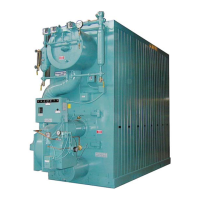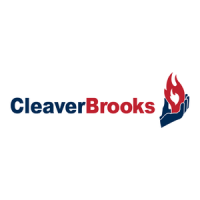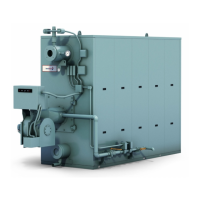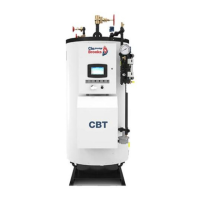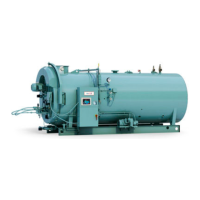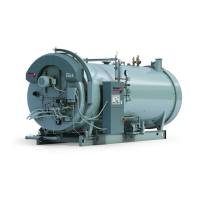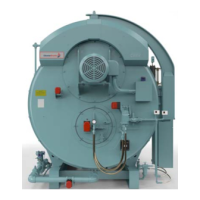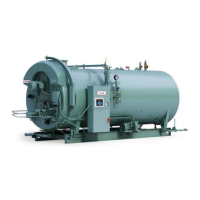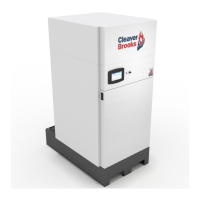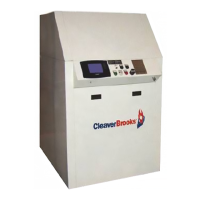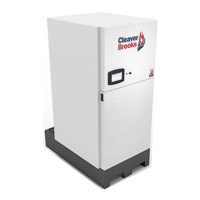Adjustment Procedures Chapter 5
750-177 5-9
It’s important to understand what the readings shown on an instrument refer to when setting combustion in
a boiler. To assist with this understanding Figure 5-5 shows the relationship between O
2
levels (excess air)
and the products of combustion for a typical flue gas analysis (natural gas).
One of the products of combustion is CO
2
(Carbon Dioxide). This is shown in percentage.
Another product of combustion is CO (carbon monoxide) and is shown in
both percentage and parts per million
(ppm). The maximum CO level standardly allowed is less than 400 ppm. However, this may change subject
to local regulations.
The percent O
2
recorded on an instrument equates to percent excess air, I.E. 3% O
2
is approximately 15%
excess air and 4% O
2
is approximately 20% excess air. The exact percentage of excess air is a mathematical
calculation based on an ultimate fuel analysis of the fuel being fired.
It is generally recommended that O
2
readings of between 3% to 5% be attained with less than 400 ppm CO,
at high fire.
Using information from Section O, determine the standard conditions of gas pressure and flow for the size
boiler and the gas train on it
. Calculate the actual pressure and flow through the use of correction factors that
compensate for incoming gas pressure and altitude.
Basically, gas adjustments are made with a gas pressure
regulator, which controls the pressure and with the
butterfly gas valve which directly controls the rate of flow.
The low fire setting should be regarded as t
entative until the proper gas pressure for high fire operation is
established.
To reach the high fire rate, turn the manual flame control
switch toward “OPEN” in minor increments while
monitoring combustion for overly rich or lean conditions.
At high fire, the gas butterfly valve should be open as wide as indicated by the slot o
n the end of the shaft.
Determine the actual gas flow from a me
ter reading. (See Section O). With the butterfly valve open and with
regulated gas pressure set at the calculated pressure, the actual flow rate should be close to the required input.
If corrections are necessary, increase or decrease the gas pressure by adjusting the gas pressure regulator,
following the manufacturer's directions for regulator adjustment.
When proper gas flow is obtained, tak
e a flue gas reading. The O
2
should be between 3% and 5% at high fire.
If the fuel input is correct, but the O
2
values do not fall within this range, the air damper settings may need
to be adjusted. Adjustment of the air damper linkage is described in Section B of Chapter 6.
With the high-fire air/fuel ratio established, the gas
pressure regulator needs no further adjusting.
After being certain that the air control damper and its linkage are corre
ctly adjusted to provide the proper
amount of secondary air, and after adjusting the gas pressure regulator, final adjustment can be made, if
necessary obtain a constant air/fuel ratio throughout the entire firing range.
Input of combustion air is ordinarily fixed at any given point in the
modulating cycle, the flue gas reading is
determined by varying the input of gas fuel at that setting. Standard Burner Low Fire Adjustment
The fuel input should be adjusted using the linkage to approximately 33%
of that at high fire. At low fire the
O
2
flue gas reading should be between 3-5%.
If the air damper needs to be adjusted in order to provide
the correct low fire air/fuel ratio, combustion must
be rechecked at higher firing rates and adjusted as required.
Q. LOW GAS PRESSURE SWITCH
Adjust the scale setting to slightly below the normal burning pressure. The control circuit will be broken when
pressure falls below this point. Since gas line distribution pressure may decrease under some conditions,
shutdowns may result if the setting is too close to normal. However, regulations require that the setting may
not be less than 50% of the rated pressure downstream of the regulator.
